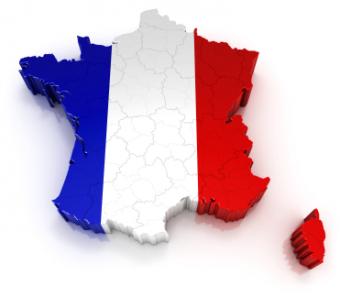
Because so many flags feature the colors red, white, and blue, it can be difficult to answer the question 'what does the French flag look like?' The colors are red, white, and blue, but they are organized differently than the red, white, and blue of the American or British flag. Perhaps even more confusing are the flags of the Netherlands and of Luxembourg, which, like the French flag, feature single stripes of these three colors, but in a different orientation, and the colors are in a different order. France's flag can be described as bleu, blanc et rouge; this is the order of the colors from left to right. Remembering it as the direction in which we read French or English may help.
What Does the French Flag Look Like
The French flag is made of three equally-sized bars of color. The colors are the same shades of red and blue as are used in the flag of the Netherlands and of Luxembourg. The French flag is organized with vertical bars; the Dutch flag is organized in horizontal bars, starting at the top: red, white and blue. The flag of Luxembourg is identical to the Dutch flag in orientation and order of colors, but features an iconic, crowned lion in the center of the flag. Picking out the French flag from other similar European flags is best done by remembering that the stripes are vertical.
There are currently two versions of the French flag made and used. The general public and the government use a flag with three equally wide stripes composing the flag. The French navy uses a slightly different flag: it is still composed of three vertical stripes: blue, white and red, but the red stripe is widest. The blue stripe is the smallest, at 30 percent of the size of the flag. The white part in the middle makes up 33 percent, and the red occupies 37 percent of the flag area. In the early 1800s, Napoleon changed the proportions of the French flag to make all three stripes of an equal size. In the 1850s, the French navy went back to the version with stripes for reasons of visual perception, especially at a distance. There are several different interpretations concerning what the three colors of the French flag represent.
Visual History of the French Flag
Before there was a blue, white and red French flag, there were several other French flags that represented either all of France or parts of it. One of the most noted predecessors of the Tricouleur (this is the name of the French flag, which is literally: three colors) were the combinations with blue and gold, sometimes with a red border or accent. The fleur-de-lis is a symbol of the French kings, and several early French flags included gold fleur-de-lis patterns on a blue background. While white is a traditional color of France, gold was more important in earlier centuries because of the strong relationship between religion and the State. While most older flags had gold as the 'light' color contrasting with blue, the modern flag features white. The blue field with a cross in it was a frequent flag design, especially in military flags.
Derived Flags
When answering the question 'What does the French flag look like?', you may stumble across flags that derived from the French flags, both old and new. The flag of Québec is a good example of a flag that resembles both the modern French flag, and some of the older French flags that preceded the Tricouleur. The flag of Québec features two colors of the French flag, blue and white, and is arranged in the traditional French way of a white cross on a blue field. In addition, the flag features four fleur-de-lis. While it is unlikely that one confuses the two flags, the symbolic lines connecting the two flags are clear.







